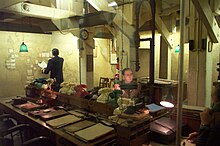Cabinet War Rooms
The Cabinet War Rooms in London is the formerly secret command center of British warfare during World War II . Construction began in June 1938 and served as the command center of the British armed forces between 1939 and 1945 . The Cabinet War Rooms have been listed as a Historic Site of Great Britain since 1948; tourists have been able to visit the rooms since the 1980s.
Construction work began in June 1938, shortly after Austria was annexed to the German Reich on March 12, 1938. During this time, the British government continued to pursue an appeasement policy towards Germany , which culminated in the Munich Agreement on September 30, 1938 . During this entire period, however, construction work on the Cabinet War Rooms, which were protected against possible air attacks, continued unabated. So was z. B. reinforced the ceiling with a concrete layer up to 3 m thick. In addition, additional pillars were installed.
On August 27, 1939, a week before the British declaration of war on the German Reich on September 3, 1939 for the invasion of Poland , the rooms 15 meters below the rear of the Treasury across from St. James's Park were full functioning. The address is Clive Steps, King Charles Street.
The premises were originally opened as the Central War Room and renamed on December 29, 1939. During the Second World War, the underground construction served the British government, i.e. the war cabinet under Prime Minister Winston Churchill , their advisors and the chiefs of staff of the military as the central command post for the coordination of the British armed forces around the world.
The top secret Transatlantic Telephone Room was set up in a former broom closet in mid-1943 , from which there was a direct telephone connection between the British Prime Minister and the US President Franklin D. Roosevelt . The line was considered bug-proof and allowed the two Allied heads of state to speak to one another directly and in full confidentiality. According to the memoirs of Walter Schellenberg , however, the research office of the Deutsche Reichspost succeeded in tapping the telephone connection.
According to the brochure of the Imperial War Museum, the facility itself was not known to many of the employees in the Cabinet War Rooms during the war. For reasons of secrecy, the door of a former toilet had been installed there, and it was often read engaged (occupied). So it was rumored that there was the "only satisfactory toilet" in the entire complex, and that it was of course reserved for the Prime Minister .
With the surrender of Japan on August 15, 1945 (official signing of the deed of surrender on September 2), the Cabinet War Rooms were no longer needed for British war planning and were shut down. The premises were then declared a Historic Site by a resolution of the British Parliament in 1948.
It was only on the initiative of then British Prime Minister Margaret Thatcher that the premises were opened to the public in their current form in the early 1980s. You are just a few steps from the Palace of Westminster , the seat of the British Parliament . A few years ago a Churchill Museum was incorporated and the name of the museum was changed to "Churchill War Rooms". In 1996 it won the Council of Europe's Museum Prize . The museum houses a copper bust of Churchill, designed by the Yugoslav Oscar Nemon in the 1950s. The two had been friends.
See also
- Paddock (bunker) , also called Cabinet War Room 2 , the possible alternative accommodation to the Cabinet War Rooms
Web links
- Official website (English)
Remarks
- ↑ website
- ↑ Nemon designed a total of 12 Churchill figures; Churchill painted Nemon once. The museum displays several of Nemon's exhibits and sells 2 replicas
Coordinates: 51 ° 30 ′ 9 " N , 0 ° 7 ′ 43" W.
